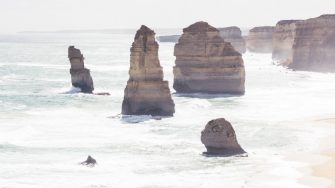
Protecting our coastal environments
Coastal zones╠řcover a diverse range of coastal ecosystems within marine, estuarine, and freshwater environments. These zones╠řare some of the most heavily populated and visited areas on the planet and they are also some of the most threatened environments. Coastal zones╠řare critically important not only to the people who live there but to╠řthe health of the planet.
A changing climate, warmer waters, rising sea levels, tropical cyclones, and coastal erosion are just some of the elements impacting coastal communities worldwide and transforming coastal environments. Coastal hazards such as storm events with associated storm surges are increasing in frequency and intensity, as are marine heatwaves that devastate coral reefs. Human activities like land reclamation, overfishing, dredging, and the construction of shipping ports are also responsible for coastal pollution╠řand degradation. The potential coastal impacts are varied and can include damage to╠řestuarine and╠řmarine environments and a loss of coastal biodiversity, or erosionÔÇöcausing permanent changes to the coastline.
Associated schools, institutes & centres
Impact
Researchers at ┴˝┴ź╣┘═° Canberra are playing a vital role in developing strategies to manage coastal changes and protect coastal systems for future generations. Our research focuses on the observation and numerical modelling of coastal╠řenvironments╠řand sea-level changes╠řdue to the impacts of climate change, anthropogenic interventions╠řand╠řmesoscale atmospheric modelling of landfalling tropical cyclones. This research supports sustainable development and improves the management of coastal zones both in Australia and worldwide.
Our research is conducted through the following research group:
Our research covers:
- Coastal Oceanography ÔÇô utilising cutting-edge technologies to explore the interactions of marine ecosystems and common environmental stressors within estuarine and coastal waters.
- Coastal and marine natural resource management ÔÇô developing a scientific and technical understanding of natural resources and marine ecology to influence the policies and practices responsible for protecting and optimising these environmental assets.╠ř
- Remote sensing and Geographical Information Systems (GIS) - utilising computer-based tools and sensors to map and analyse the EarthÔÇÖs surface to assist in the sustainable management of natural resources and address the threats of climate change.
Our researchers
-
We work closely with the╠ř╠řand several other Chinese partners in collaborative research on coastal oceanography and management. The ┴˝┴ź╣┘═° Canberra campus and several faculties of ┴˝┴ź╣┘═° in Sydney contribute to the╠ř.
-
- ╠ř
DS Byun, XH Wang and PE Holloway, 2004,╠ř, Korea. Estuarine, Coastal and Shelf Science 59 (2), 185-196╠ř
D Song, XH Wang, X Zhu and X Bao, 2013,╠ř. Estuarine, Coastal and Shelf Science 133, 147-160╠ř
XH Wang and N Pinardi, 2002,╠ř. Journal of Geophysical Research: Oceans 107 (C12), 18-1ÔÇô18-23╠ř
XH Wang, 2002,╠ř. Journal of Physical Oceanography 32 (11), 3113-3131╠ř
F Zhang, XH Wang, PALD Nunes and C Ma, 2015,╠ř╠řEcosystem Services 11, 106-114╠ř
G. D. Gao, X. H. Wang, D. Song, X. Bao, B. S. Yin, D. Z. Yang, Y. Ding, H. Li, F. Hou, Z. Ren, 2018,╠ř, Journal of Physical Oceanography╠ř
Z. Huang and X. H. Wang, 2019,╠ř. Remote Sensing of Environment. 227, 90-109╠ř
I. Jal├│n-Rojas, X.H. Wang and E.╠řFredj, 2019,╠ř, Marine Pollution Bulletin, 141, 256-272.╠ř
X. H. Wang, Y. X. Gao, Q. Wang, T. He, W. Guan and F. Chai, 2019, Recent Development in Coastal Oceanography ÔÇô Physics, Biology and their Interactions. Encyclopedia of Water: Science, Technology, and Society. ISBN: 978-1-119-30075-5, John Wiley & Sons╠ř
Yue Ma, Nan Xu, Zhen Liu,╠řBisheng╠řYang,╠řFanlin╠řYang, Xiao Hua Wang, Song Li, 2020,╠ř. Remote Sensing of Environment
-
- Determining and understanding the impact of regional climate on estuarine physical processes under the influence of climate change on the east coast of Australia╠ř
- On the East Australian Current Encroachment: Remote Sensing, Quantitative Mapping and Spatio-temporal Variability╠ř
- Downscale modelling of a macro-tidal estuary under climatic and anthropogenic scenarios: Where is Darwin Harbour heading╠ř
- Estuarine circulation and sediment transport during cyclone induced storm surge in the Ganges-Brahmaputra-Meghna delta╠ř
- Development of a coupled catchment-ocean model for sediment transport in the coastal oceans╠ř
-
- Wenjun Zhu
- Marin Akter
- Panpan Lu
- Thi Thuy Nguyen
- Nazeat Ameen Iqra
- Numan Al Kibriya
-
- Successfully produced numerical simulations of Darwin Harbour which indicate that if the mangroves and tidal flats are reclaimed, the total sediment flux could be orientated reversely from seaward to landward causing increased harbour siltation.
- Successfully developed marine microplastic tracking model╠řTrackMPD. The╠řmodel╠řtracked and predicted the dispersion of lost cargo debris due to the Port Stephens shipping container spill in May 2018.╠ř
- Successfully produced numerical simulations of Darwin Harbour which indicate that if the mangroves and tidal flats are reclaimed, the total sediment flux could be orientated reversely from seaward to landward causing increased harbour siltation.

